
Lantana is a genus of about 150 species of perennial flowering plants in the verbena family, Verbenaceae. They are native to tropical regions of the Americas and Africa but exist as an introduced species in numerous areas, especially in the Australian-Pacific region, South and Northeastern part of India. The genus includes both herbaceous plants and shrubs growing to 0.5–2 m (1.6–6.6 ft) tall. Their common names are shrub verbenas or lantanas. The generic name originated in Late Latin, where it refers to the unrelated Viburnum lantana.

A wildflower is a flower that grows in the wild, meaning it was not intentionally seeded or planted. The term implies that the plant is neither a hybrid nor a selected cultivar that is any different from the native plant, even if it is growing where it would not naturally be found. The term can refer to the whole plant, even when not in bloom, and not just the flower.
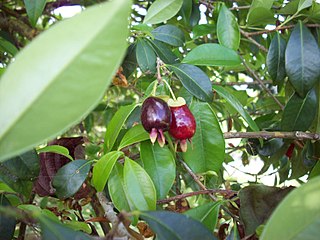
Eugenia involucrata, the Cherry of the Rio Grande, is an evergreen shrub native to Brazil which bears small fruits that are dark red to purple in color and have a sweet cherry-like flavor. They are hardy to 20F when mature, though younger plants should be protected from frosts.

Mentzelia involucrata is a species of Mentzelia native to the Mojave and Sonoran deserts of North America as well as places in Nevada, Arizona and Baja California (Mexico). Its common names include kuʼu, sand blazing star and white-bract blazing star.

Pilea, with 600–715 species, is the largest genus of flowering plants in the nettle family Urticaceae.

Lonicera involucrata, the bearberry honeysuckle, bracted honeysuckle, twinberry honeysuckle, Californian Honeysuckle, twin-berry, or black twinberry, is a species of honeysuckle native to northern and western North America.
Leucaena involucrata is a species of flowering plant in the family Fabaceae. It is endemic to Sonora state in northwestern Mexico.
Aetheolaena involucrata is a species of flowering plant in the aster family, Asteraceae. It is endemic to Ecuador, where it is considered to be "characteristic" of the Andean flora.

Lantana camara is a species of flowering plant within the verbena family (Verbenaceae), native to the American tropics. It is a very adaptable species, which can inhabit a wide variety of ecosystems; once it has been introduced into a habitat it spreads rapidly; between 45ºN and 45ºS and more than 1,400 metres in altitude.
Lantana pastazensis is a species of flowering plant in the verbena family, Verbenaceae, that is endemic to Ecuador. Its natural habitat is lowland tropical moist forests. It is mildly toxic due to the presence of pentacyclic terpenoids.
Melicope haupuensis is a species of tree in the family Rutaceae known by the common names Haupa Mountain melicope and Pacific pelea. It is endemic to the Hawaiian Islands, where it is known only from the island of Kauai. It is threatened by habitat loss. It is a federally listed endangered species of the United States. Like other Hawaiian Melicope, this species is known as alani.
Pentagonia involucrata is a species of plant in the family Rubiaceae. It is endemic to Ecuador.
Peperomia involucrata is a species of plant in the family Piperaceae. It is endemic to Ecuador.
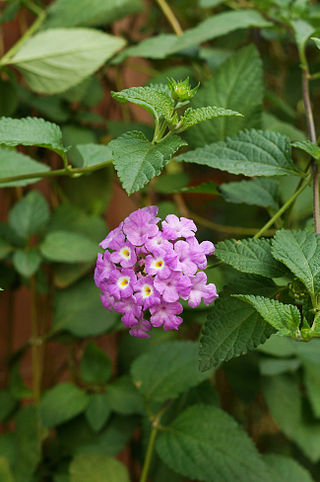
Lantana montevidensis is a species of lantana known by many common names, such as: trailing lantana, weeping lantana, creeping lantana, small lantana, purple lantana or trailing shrubverbena.

Salvia involucrata, the roseleaf sage, is a species of flowering plant in the sage family Lamiaceae. This herbaceous perennial is native to the Mexican states of Puebla, Tamaulipas, and Veracruz, growing in shady places such as the edge of forests. Its specific epithet involucrata refers to the prominent flower bracts, which are large and colorful.
Ronnbergia involucrata is a species of flowering plant in the family Bromeliaceae, endemic to Ecuador. It was first described in 1888 as Aechmea involucrata.

Lantanophaga pusillidactyla, the lantana plume moth, is a moth of the family Pterophoridae. It is native to the southern United States, Mexico, the Caribbean, and South America. It was introduced to Australia accidentally in 1936 and is now found from Sydney to Cairns along the coast. It has also been introduced to Hawaii in 1902, Pohnpei in 1948, and Palau in 1960 for biological control. It has since been recorded from Yap in 1987–1988 and is now distributed on all islands of the Mariana and Caroline Islands where the host plant is found, except Aguijan.
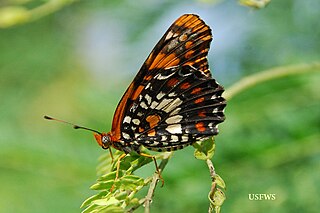
Atlantea tulita is a rare species of butterfly known by the common name Puerto Rico harlequin butterfly. This brush-footed butterfly is endemic to Puerto Rico. It is a candidate for United States federal protection as an endangered species. In 2011 a report found federal protection to be warranted, but it was precluded by other actions and it remains a candidate.
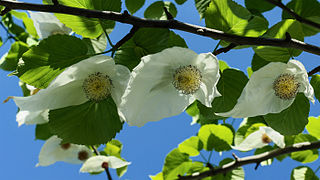
Davidia involucrata, the dove-tree, handkerchief tree, pocket handkerchief tree, or ghost tree, is a medium-sized deciduous tree in the family Nyssaceae. It is the only living species in the genus Davidia. It was previously included with tupelos in the dogwood family, Cornaceae. Fossil species are known extending into the Upper Cretaceous.
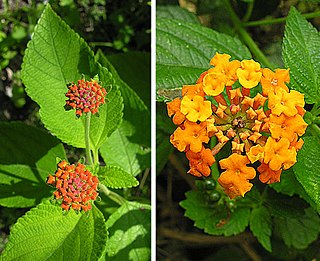
Lantana urticoides, also known as Texas Lantana, is a three- to five-foot perennial shrub that grows in Mexico and the U.S. states of Texas, Louisiana and Mississippi especially along the Gulf coast. The plant can blossom from spring until the first frost. It is a species of flowering plant within the verbena family, Verbenaceae.














